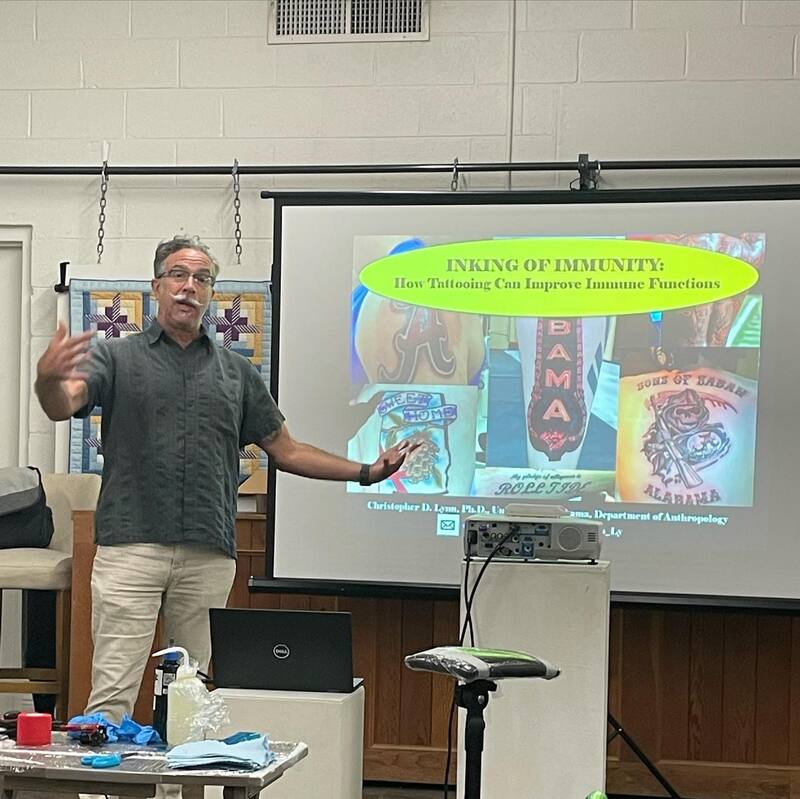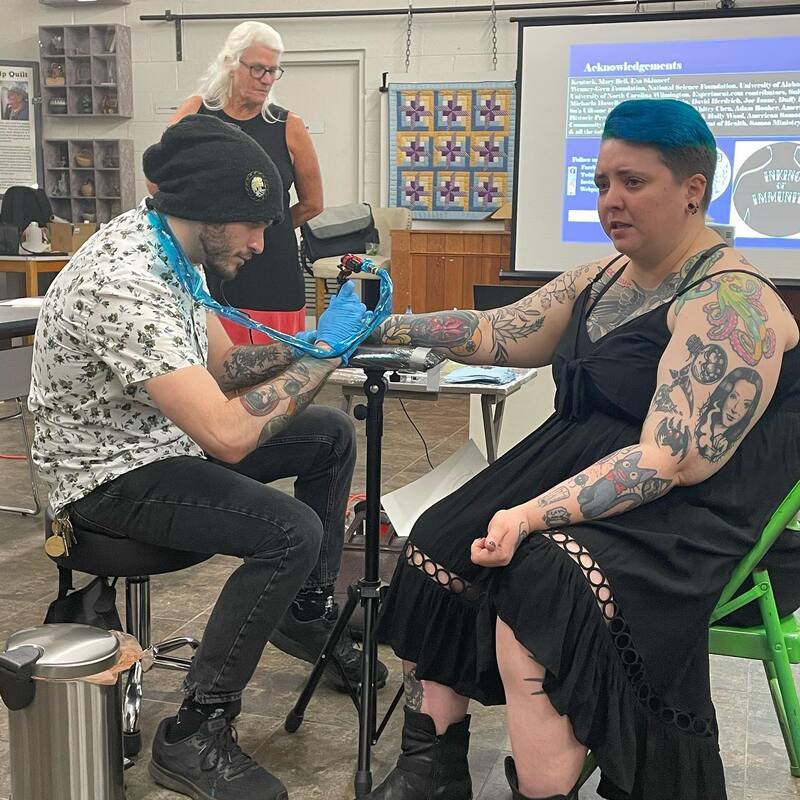|
Another nice piece recently came about tattooing and immune function that I was interviewed for. This one is in Parade Magazine:
https://parade.com/health/tattoos-immune-system
0 Comments
It's gratifying to be contacted for excellent pieces like this new one that came out in The Atlantic last week. Katherine Wu digs into the various studies of tattooing and the immune system, including comments from a phone conversation we had a few months ago.
www.theatlantic.com/science/archive/2023/03/tattoo-science-immune-system-effects/673462/ I spent the week of UA's spring break in Samoa to get the project I was awarded NSF funding for in 2020 started finally. I spent 5 weeks this past summer in Honolulu talking with the Samoan diaspora community and had intended to collect similar data in Samoa via coordinated training of research assistants at the Centre for Samoan Studies at the National University of Samoa. However, having only arranged these relationships via email, I could not wrap my brain around how I was going to accomplish those things, and, after chatting with Jessica Hardin, another anthropologist who works with CSS for research in Samoa, I realized the best strategy would be to pay for an extra plane ticket and make the trip to have some meetings in person about the project.
I stayed at the Samoan Outrigger Hotel because it cost about as little as a cheap AirBnB and is located close enough to the Samoan Cultural Village, where Suluape Tatau do hand-tap tattooing, and the National University of Samoa, where I would be giving a talk and have meetings. I went down to the Cultural Village right after I arrived, but no one was tattooing so I popped into a bar overlooking the Village and Apia Bay to see who was around. It was happy hour and full of Kiwi expats talking about their schemes to make money. Felt like a James Michener novel, but I guess everyone needs to make a living. The flight there is super long, and Samoa is 18 hours ahead of US Central Time, so I left on Sunday at 2PM, but I didn't arrive in Samoa until Tuesday afternoon. But I didn't have any appointments until Thursday, so I tried to find everyone on Wednesday. I walked around looking for NUS and CSS for several hours, and I finally found everyone I was looking for after getting thoroughly sunburned and foot-blistered. My stupidity for forgetting a hat, sunscreen, or my already broken in slides. I found Dionne Fonoti in CSS and the main offices and met a few other folks over there. Then I walked down to the Cultural Village and found Ata Sulu'ape tattooing. Junior (Paul) was in Pago Pago, and their father Alaiva'a was at home. Ata told me their father doesn't come down to the Cultural Village anymore, and I didn't have a car so didn't seem him while there. However, right as I was leaving, his daughter Patricia saw on FB that I was in Samoa and sent a message, leading me to realize I could have reached him through the daughters. I didn't think of it though, so next time. On Thursday, I gave a seminar talk about the research I've done and tried to describe the goals and methods I am planning for the Samoa project. The seminar was very well attended with lots of great questions and several people excited to potentially work with me. More on that in a paragraph or so. On Friday, I had some meetings to determine, now that my plans were somewhat clear, how CSS and I could help each other. Much of it revolved around who would be available to take on extra work. I'd be training and paying the person or people, but NUS does have have biological anthropology. They have cultural and language studies and archaeology. There was a medical doctor who is president of the Malofie Association, which is an association of people with the pe'a. I've been trying to catch up with him ever since, but he's super busy as a surgeon and director of the teaching medical program. On Saturday, I had a fruitful breakfast meeting with Dionne, her partner, and Greg Jackmond, the archaeologist at CSS. We talked a lot about the tatau project and generally got to know each other, but I also got the opportunity to hear about some amazing archaeology and bioarchaeology material they have that they're looking for help analyzing. So now, as part of our exchange, I'm trying to find students and colleagues who could help them with this analysis or who may be interested in doing archaeology research there. Contrary to my beliefs that anthropologists have been studying Samoa ad nauseum forever, it's really that anthropologists have popped in now and again and written books but never maintained a constant presence. The archaeology that's been done there has languished since the 1970s, save the occasional study to reify the Lapita story of peopling the Pacific. It's really still unknown why people migrated there or spread out and migrated from there to other Polynesian Islands. However, they have LiDAR data indicating Savai'i was once extensively inhabited, and there is tons of evidence of prehistoric habitation that is completely unexplored. Sunday is the day of the Lord, so no meetings. Frankly, most Samoans are so booked up with chief, village, and church responsibilities on the weekends that they're more busy than during the workweek. So I spent Sunday watching Alabama play basketball (in March Madness, the Saturday night game in Alabama was Sunday morning in Samoa) then went to a hike up to Robert Louis Stevenson's house and grave again. I'd been there last time but got caught in the rain. This time I walked in intense sun and got another sunburn. Monday was the day I was supposed to leave, but since the flight was at 8pm, I had time for some more meetings, which was providential. I had breakfast with Bernadette Samau-Sila, who is a Lecturer in Finance and Marketing. She's Samoa-born but raised and schooled in New Zealand. Shes a qualitative researcher whose methodology is perfect for the study I've proposed, which is why she reached out. She's done some research on the malu and just loves research, and I'm really looking forward to combining our ideas to make this project better. I headed back over to NUS with her after breakfast and went to see Greg's LiDAR maps, which I then played with for several hours until I needed to get to the airport. Our new paper mentioned in the previous post is out, Open Access, in the Nature subsidiary journal Humanities & Social Science Communications. We're pretty stoked to have open access in a Nature journal. Is that big time? It is in my head!
Furthermore, I'm really proud of the students in my lab who stuck in there for Zoom meetings over the course of a year as we figured out how to do a scoping review, write it up, and get it published. Here is the DOI for the paper, where everyone can read it: https://www.nature.com/articles/s41599-023-01511-6 One of our local arts organization, which actually hosts the best folk art festival in the world imho, started a new series for its adult patrons called Kentuck After Dark. I love Kentuck's annual Folk Art Festival, which is coming up in mid-October, as well as its monthly First Thursday events, and so many of the artists and employees there. It's one of the best things about Tuscaloosa. So I was delighted when they invited me to give a tattoo dark for the second installment of Kentuck After Dark on August 18. This was a small ticketed event with wine and cheese. It was easy to chat with everyone, and Molly made some delightful mojitos.
Here are a few photos by my wife Loretta Lynn, including a few of me give a talk about tattooing and immune function from me followed by tattooing with Q&A by local tattoo artist Lucas McDaniel. My kids got their first tattoos from Lucas, so he's had to put up with me ad nauseum, making this an easy event for us to work together. |
Christopher D. LynnI am a Professor of Anthropology at the University of Alabama with expertise in biocultural medical anthropology. Archives
May 2023
Categories
All
|








 RSS Feed
RSS Feed
